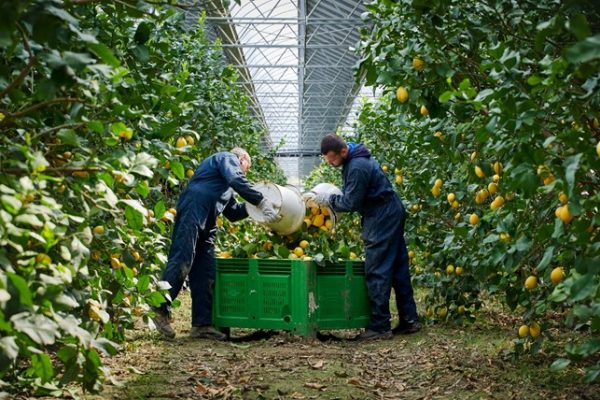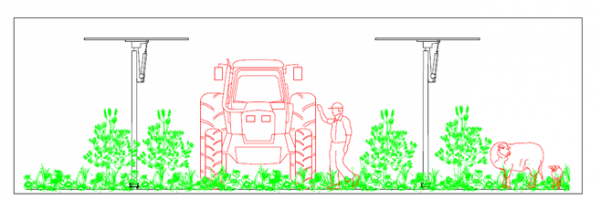“Together with EF Solare we wanted to develop a model that would be sustainable, both from an agricultural and energy point of view – Antonio Lancellotta, Le Greenhouse
AGRO-PHOTOVOLTAIC: A TOOL FOR THE PRODUCTION OF CLEAN ENERGY THAT IS ALSO GOOD FOR THE TERRITORY
Agro-photovoltaic, an important contribution to achieve the goals of PNIEC
Italy needs to increase the production of renewable energy and in particular solar to advance in the de-carbonization, in fact, the PNIEC has established that the photovoltaic power installed in 2030 must be more than 50 GW. This target will also be increased following the new European objectives that foresee a 55% reduction in CO2 emissions by 2030. The main problem in reaching this target is to combine energy needs with those of agriculture and pastoralism, from which productive land must not be taken away. In some countries, such as France, China, Japan and some U.S. states, governments have favored the spread of agro-photovoltaics where the production of electricity is integrated with the activities of cultivation and / or pastoralism.
In Italy
Contrary to the perception of many, the areas in which agro-photovoltaic projects are developed can be an opportunity to recover the territory to agro-pastoral activities. The Renewable Energy Report 2021 of the Politecnico di Milano, estimated that for the installation of 30 GW of photovoltaics would be sufficient 0.36% of used agricultural areas or less than 4% of unused agricultural areas. Moreover, thanks to EF Solare’s innovative approach to agro-photovoltaics, it will not even be necessary to occupy this land as EF can operate with essentially zero land consumption.

EF Solare’s experience in agro-photovoltaics
EF Solare is a pioneer in the agro-photovoltaic sector in Italy where, for more than 10 years, it has been present with photovoltaic greenhouse projects in Umbria, Sardinia and, in particular, Calabria, where the Group has 7 plants that produce about 25 million kilowatt-hours annually, capable of satisfying the electricity needs of more than 9,000 families, with a reduction of more than 11,000 tons of CO2 emissions. This experience has allowed EF Solare, together with the agricultural company Le Greenhouse, to develop a new model of agro-photovoltaic with panels placed on high structures, spaced out and equipped with sun tracking systems. In this way, in the same area, it will be possible to coexist production of clean energy, agricultural activity and pastoralism.

10 benefits of agro-photovoltaic for the territory
1. Allows a double use of land.
2. Contrasts the abandonment of agricultural land, increasing productivity.
3. Creates new employment opportunities in communities by providing greater job continuity than open field.
4. Protects crops from extreme weather events caused by climate change, high temperatures, and new parasites.
5. Contributes to decrease water needs, protecting crops from heat and reducing evapotranspiration, requiring up to six times less water than open field crops.
6. Promotes higher photosynthetic capacity and generates high quality crop yields.
7. Stimulates investments that increase farm competitiveness through digitalization and risk diversification.
8. Improves the efficiency of photovoltaic modules due to the cooler microclimate generated below the panels.
9. Optimizes the operating costs of the photovoltaic system
10. Represents a useful tool for sharing value among the various stakeholders
The farmer’s point of view
The agro-photovoltaic is not only a system for the production and use of renewable energy but also represents a valuable tool for agriculture to evolve and renew itself by contributing to the birth of an agriculture 4.0 more sustainable. EF Solare has been able, in fact, to develop the first experiences of photovoltaic greenhouses thanks to the conviction and collaboration for over 10 years of the farm Le Greenhouse, managed for generations by the Lancellotta family. “Together with EF Solare we wanted to develop a model that would be sustainable, both from an agricultural and energy point of view – said Antonio Lancellotta of Le Greenhouse – so 10 years ago, we decided to build the first photovoltaic greenhouses to protect cedars from bad weather and sun. Thanks to the micro-climate that is created inside the photovoltaic greenhouses, it was possible to cultivate a particular type of cedar closely connected to the history and the territory of Calabria. Under the greenhouses in Milis (Sardinia), we cultivate the Sardinian pompìa among the other various citrus fruits. The careful observation of the territory and its crops – continues Antonio – is a fundamental prerogative and still today is the basis of the new agro-photovoltaic projects that we are carrying out in collaboration with EF Solare”.

The future of agro-photovoltaics
EF Solare, as the first photovoltaic operator in Italy, works every day to promote a sustainable restart through the development of renewables in a coherent and efficient way, creating photovoltaic models able to integrate and coexist in harmony with the territory and communities. New agro-photovoltaic projects are now being developed and will be essential to achieve the urgent energy transition by realizing a rapid de-carbonization, also for the agricultural sector, useful to safeguard the biodiversity of the planet by creating a truly sustainable future.


